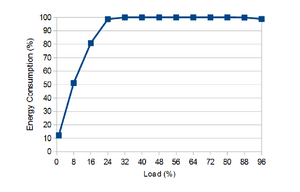Energy Efficient Ethernet
Energy Efficient Ethernet (EEE) reduces the energy consumption of network connections by introducing a Low Power Idle mode. In conventional Ethernet connections, the Ethernet transmitters (sender) continuously send an auxiliary signal (IDLE signal) to synchronize the sender and receiver. A 1 Gb/s transceiver typically requires 0.5 watts of power for this, while a 10 Gb/s GBASE-T transceiver requires up to 5 watts. Defined in the IEEE standard 802.3az, the EEE Low Power Idle Mode enables energy savings when no or few packets are sent.
Requirements
For EEE to work, EEE must be supported by both the Ethernet switch and the network adapter in the server or PC.
Networkchips with EEE Support
[[Datei:X9SCM-F-NICs.png|thumb|250px|The Intel 82579 Gigabit Network Chip with IEEE 802.3az support is used on the Supermicro X9SCM-F Motherboard as LAN port 2.[3]]]For example, the following network chips / network cards support EEE:
- Intel 82579 (e.g. Supermicro X9SCM-F Motherboard LAN Port 2)
- Intel I210
- Intel I211
- Intel Ethernet Server Adapter I350 Series
- Intel I226
Switches
Many switches support EEE. NETGEAR Web Managed Switches and Smart/Fully Managed Switches have EEE disabled by default and can be enabled using the appropriate features.[4]
The following screenshots show the menu items of a M4300 switch:
Further Information
- Energy Efficient Ethernet (en.wikipedia.org)
- Saving Power and Money with Energy Efficient Ethernet (EEE) (Dan Schaffer, 03.09.2020)
- Energy-efficient Ethernet has arrived, with real savings (www.infoworld.com, 31.12.2010)
- Disabling Energy Efficient Ethernet (EEE) (usa.yamaha.com)
- Augmenting the Energy-Saving Impact of IEEE 802.3az via the Control Plane (Conference Paer, IEEE ICC 2015 - Workshop on Next Generation, Juni 2015)
- Evolution of Ethernet Speeds: What’s New and What’s Next (DENOG7, 2015)
- An Overview of Energy Efficient Ethernet ( North American Network Operators’ Group YouTube Channel, Michael J. Bennett, 2015)
References
- ↑ Augmenting the Energy-Saving Impact of IEEE 802.3az via the Control Plane (Conference Paer, IEEE ICC 2015 - Workshop on Next Generation, Juni 2015)
- ↑ ns-3 | a discrete-event network simulator for internet systems (www.nsnam.org)
- ↑ X9SCM-F User Manual
- ↑ What is IEEE 802.3az Energy Efficient Ethernet? (kb.netgear.com)
|
Author: Werner Fischer Werner Fischer, working in the Knowledge Transfer team at Thomas-Krenn, completed his studies of Computer and Media Security at FH Hagenberg in Austria. He is a regular speaker at many conferences like LinuxTag, OSMC, OSDC, LinuxCon, and author for various IT magazines. In his spare time he enjoys playing the piano and training for a good result at the annual Linz marathon relay.
|








